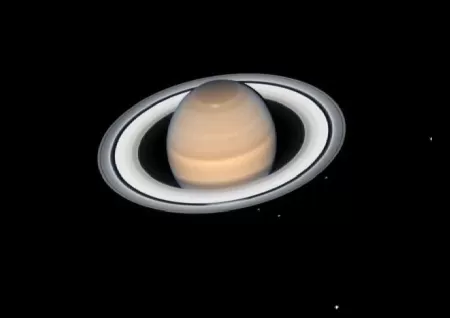NASA's Hubble Captures Start Of A New 'Spoke' Season Of Saturn

According to a NASA release, spokes on Saturn's rings signalled the beginning of a new "spoke" season in the most recent photograph of the planet taken by the Hubble Space Telescope of the National Aeronautics and Space Administration (NASA). According to the announcement, scientists will search for hints that will help them understand the origin and makeup of the spokes. The planet's fluctuating magnetic field is thought to be the cause of the spokes, according to the statement. Solar wind and planetary magnetic fields combine to produce an electrically charged atmosphere. Solar wind and planetary magnetic fields combine to produce an electrically charged atmosphere. The aurora borealis, or northern lights, are visible in the northern hemisphere when charged particles hit with the atmosphere on Earth, according to NASA scientists believe that even the tiniest dust-sized ice ring particles have the ability to charge up and momentarily elevate themselves over the surrounding bigger frozen particles and boulders. Saturn has four seasons, just like Earth, and is inclined on its axis, much like Earth. However, due to Saturn's far bigger orbit, each season lasts around seven Earth years, according to the space agency. When the rings are tilted edge-on to the sun, the equinox occurs.According to the space agency, the spokes vanish when Saturn is close to its summer or winter solstices, which occur when the sun seems to be at either its greatest or lowest latitude in either the planet's northern or southern hemisphere, respectively. As Saturn's northern hemisphere's autumnal equinox The spokes are predicted to grow more visible and noticeable as May 6, 2025, approaches, according to the announcement. The development of two murky spokes in the B ring, one of Saturn's rings, in the most recent image taken by Hubble, the statement stated, marks the beginning of the "spoke season" for Saturn. Ephemeral characteristics are fleeting, but more will manifest as the planet's autumnal equinox draws near, according to the statement.
Early in the 1980s, NASA's Voyager spacecraft made the first detection of the ring spokes. According to lighting and viewing angles, the fleeting, enigmatic shapes might look light or dark, the statement claimed."Thanks to Hubble's OPAL programme, which is establishing a library of data on the outer solar system planets, we will have longer devoted time to study Saturn's scientist Amy Simonspokes this season than ever before," said NASA senior planetary the program's leader. Thanks to the OPAL programme, NASA's Hubble Space Telescope has observation time each year allocated to Saturn, and the dynamic gas giant planet consistently revealed something new, according to the space agency. The most recent equinox on Saturn happened in 2009, when NASA's Cassini probe was orbiting the gas giant planet for up-close exploration, according to a statement from the agency. Despite Cassini's mission ending in 2017 and the Voyager spacecraft being long since destroyed, Hubble is still working on long-term Saturn and other distant planets will be monitored for changes, according to the space agency. The precise start and length of the spoke season remain unknown, Simon added, "much like anticipating the first storm during hurricane season, despite years of superb monitoring by the Cassini probe."
The statement claimed that while the other three gas giant planets in our solar system have ring systems as well, nothing comes close to Saturn's distinctive rings, which serve as a laboratory for research on spoke phenomena. The existence of spokes on other ringed planets is yet unclear, according to NASA. For the time being, Simon added, "It's a fascinating magic trick of nature we only witness on Saturn." According to NASA, Hubble's OPAL mission will enhance the library of Cassini observations with spectroscopic and visual data covering wavelengths of light from ultraviolet to near-infrared.
Related queries to this article
- NASA
- Hubble Captures
- New Spoke Season
- Saturn
- National Aeronautics
- Space Administration
- Hubble Space Telescope
- NASA scientists
- NASAs Voyager Spacecraft
- Hubbles OPAL programme
- Scientist
- Amy Simonspokes
Read more articles and stories on InstaSity Latest News.





